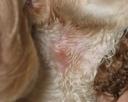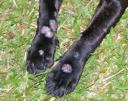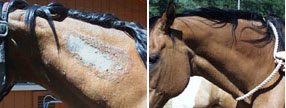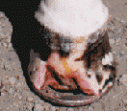Alopecia is loss of hair from areas of the body where hair is usually found. This is so for hair loss in canine skin disorders and is as a result of a disease called alopecia areata which attacks the hair follicles. In canine skin disorders, this is the part of the skin where hair grows and falls out at the size of a quarter in round patches. Also known as an autoimmune disease there is a very interesting fact about alopecia (hair loss) which forms part of canine skin disorders. Under normal circumstances the immune system protects the body against illness, however in alopecia the immune system attacks its own body (by error) in this case hair follicles causing hair to fall out. Scientists do not know the cause of this, however have listed that “genes†may play a role in canine skin disorders.
 Dog Skin Conditions – Hot Spot
Dog Skin Conditions – Hot Spot
 Dog Skin Conditions – Ring Worm
Dog Skin Conditions – Ring Worm
 Dog Skin Conditions – Staph Infection
Dog Skin Conditions – Staph Infection
 Dog Skin Conditions – Mange
Dog Skin Conditions – Mange
Dog dry skin has a low level of sebum and an inability to retain moisture. Usually the skin will feel tight and if cracked, shows a severe case if dehydration. In the case of dog dry skin this will escalate in winds and increase temperatures causing the skin to flake. When oil glands do not supply enough lubrication to the skin, it becomes dehydrated and dog dry skin will then have to be treated with a solution which is not only for topical care, but will addres the illness from the inside out. Along with a genetic condition, dog dry skin can be caused from an underactive thyroid. All of the above will ultimately cause the skin to be sensitive and will require a nurturing approach when treating.
Types of Laminitis:
Seedy Toe
Classical Laminitus
Road Founder Type
White Line Disease and the above related diseases have many of the same symptoms and can be treated much in the same way. However, it is the road founder type laminitis which is quite different and maybe deserves a brief overview. This type illness occurred mainly in heavy carriage horses which were used on the turnpikes of Europe. Unlike White Line Disease, road founder is the actual tearing away of the laminae, near the distal border of the coffin bone. In severe cases, the horse would go lame which is always a bad thing. All hoof related illness including white line disease is of a serious nature and therefore should be treated correctly.

Hair Loss forms part of horse diseases in the equine industry and can be easily noticed as:
-areas of “missing maneâ€
-horses tail
-underneath the girth, saddle or blanket
-bald patches on the coat
-scabs falling off with losing hair.
Sometimes in horse diseases, it is hard to tell if your horse is suffering from general hair loss or something which may need a veterinarian’s opinion. Sometimes when using nutritional supplements, allergic reactions can occur such as hives, bumps or scabs. Horse diseases such as microsporum ringworm can start as alopecia with no scabs and will need a culture done for proper diagnosis.  The general rule about any hot area on the body (horse diseases) is most likely an infection and should not be ruled out when caring for hair loss symptoms.
Dog skin problems are the most common health issues in dogs. You will be interested to know that many dog skin problems that afflict humans, are actually counterpart in dogs. If you look at your dogs skin, this will be an important indicator to show the health state of your pet. Dog skin problems are grouped into catergories according to their cause eg: immune, infectious or flea. Although dog skin problems are usually due to a deficiency in the dogs immune system there may be other factors such as inherent abnormalities of the skin structure. If your dog skin problems persist you need to seek professional medical advice!
If your vet tells you your pet is suffering from a skin disorder, do you really understand what he/ she means? Canine Skin Disorders – this would refer to a disturbance or interuption in the normal funtioning of your dogs skin! Break up the word disorder and what do you get? Dis-order. Just as in dis-ease, when a healthy body is not at-ease. Canine Skin Disorders can be genetic, it can be caused by trauma or symptematic to the outside environment.  The word disorder is used across the board to describe human conditions or anything out of alignment with its natural state of working order as also in canine skin disorders.
 way. This would greatly minimise the need to treat your pet from any dog skin conditions which could cost you time, money and an unhappy friend.
way. This would greatly minimise the need to treat your pet from any dog skin conditions which could cost you time, money and an unhappy friend.Your dog suddenly develops a new behavior. He is doing one of three things or all of them together, scratching, biting or licking his fur. This would mean your pet has “dog dry skin“. If you take close enough notice to the time of year this is most likely to happen, it will be when the weather becomes cooler, during the autumn or winter months. If your pet suffers from dog dry skin, you would see some of the following symptoms ie: skin irritation, open sores on the body, loss of hair and your dog seems to be licking his face / feet more often than usual. Dog dry skin is a problem for many pets, however this does not have to be the case. Some of the things you can do to prevent dog dry skin is – do not bathe your dog too often and when you do, make sure you use dog shampoo. Brush your dog often to remove dead hair and use quality food and supplements. Dog dry skin can be treated most effectively with an animicrobial body wash as a preventative measure as well as a cure.
White Line Disease and why a professional diagnosis is so important. We had a lady who’s horse was shod approx 2 weeks ago. She was in the process of finding a new farrier following the retirement of her current one. He said her horse had white line disease in three of the hooves. The only outer sign was a white line where the hoof wall ended. The hoof was not breaking off or anything of that nature as in the accompanying picture.
If it was white line disease the distinct line would have stayed, however after a week the horse was shod the line, what appeared to be “white line disease†was not a disease at all. Only where the farrier had trimmed the hoof too short which reached a bit of flesh point. White line disease is a serious illness and should be diagnosed by a veterinarian, not only by first opinion of the farrier. If not treated properly the horse will founder and a portion of the hoof will need to be cut away. This is not a pretty sight! If you are suspicious of your horse developing white line disease, always obtain a professional opinion.

No comments:
Post a Comment